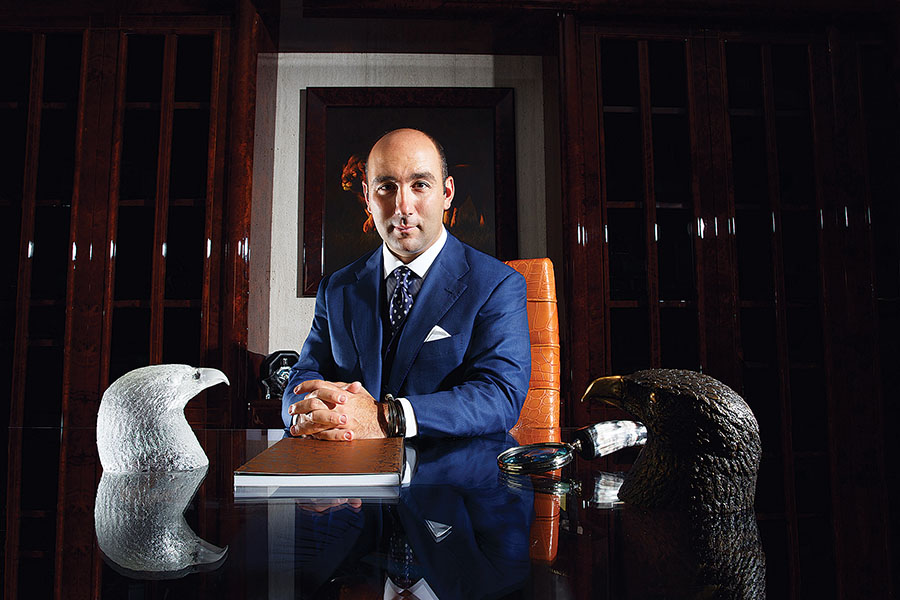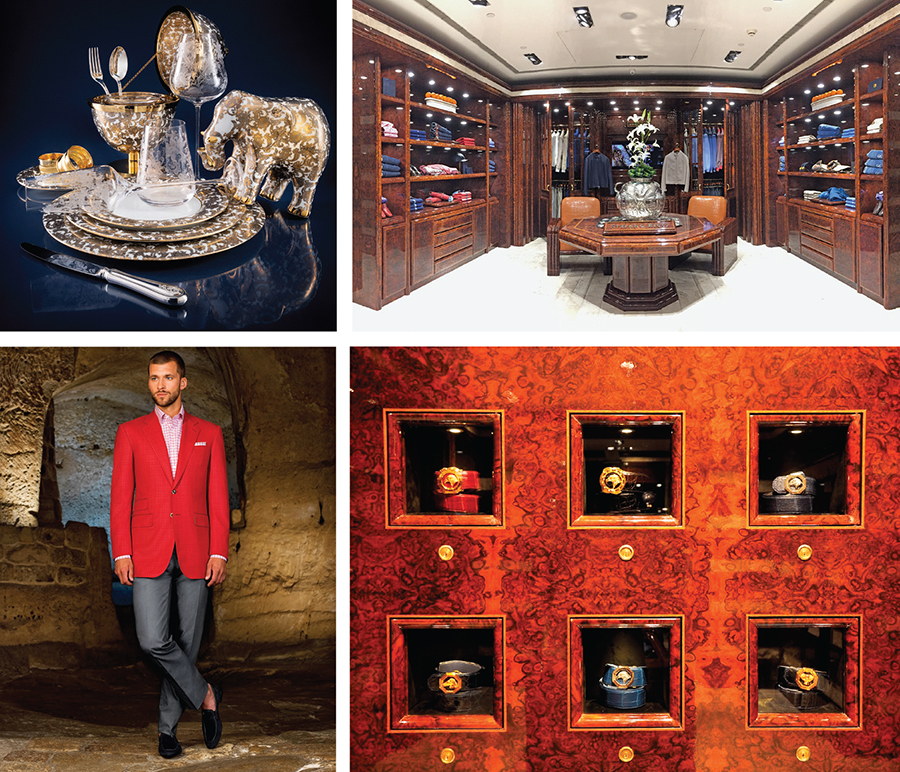
Luxury is a matter of personal pleasure: Filippo Ricci
The creative director of luxury brand Stefano Ricci on extending their range from menswear into lifestyle, and why they will not pursue Gen Z

Clothiers to the uber rich and famous, to oligarchs and movie stars, the Stefano Ricci brand is known for its diamond-studded ties and crocodile-skin shoes, for $25,000 custom suits and limited edition $230,000 handbags. With 62 boutiques worldwide, including two recent ones in Hong Kong and Phnom Penh, the brand opens its second India store in New Delhi (the first opened in Mumbai). Stefano’s son Filippo Ricci, 35, creative director at Stefano Ricci, talks to Forbes India about India as a market and why they got into the home space. Excerpts:
Q. What are your first memories about the business?
My first memories are nice, considering that both my brother Niccolò [CEO at Stefano Ricci] and I used to go to our grandmother’s house to study after school each day. And our first home was on the ground floor of her villa. We, therefore, breathed in the scents of silks and fabrics, and we met international clients who were treated as family friends. Even my first work experience, which I think took place at the Pitti Uomo fair in Florence, was a fundamental moment of growth, before there was any obligation. What I love most is to sit down at my desk and transform the inspiration that I draw from travelling the world into projects: A colour, a design, a perfume.
Q. The Stefano Ricci brand started with ties, became a menswear brand, and then a lifestyle one. How did each of these lead to the next? What’s next?
My father founded the company in 1972, starting from a ties workshop in Florence. He was a collector and cultivated his dream: To make the most beautiful tie in the world. Two years later, he also began to produce shirts. We initially produced accessories, and yet we arrived at the beginning of the 1990s with a total look, around the same time that we opened our first boutique in Shanghai.
As my brother (Niccolò) and I entered the company [in 2003 and 2007, respectively], we wanted to write a new chapter in the history of the brand, extending production towards a concept of luxury lifestyle, with the SR Home Collection that coordinates the activities of the interior design division with high-end tableware and furniture offerings. This started as a request from our customers, who wanted to live a total lifestyle experience. The yacht space too happened similarly. The next project? We are developing many different ones. What absorbs most of my energy at the moment is the Stefano Ricci watch.
Q. How did the latest menswear collection come about? Where do you draw inspiration from?
My father designs the essential features of a collection and I, along with the style office, define the elements for international markets. Inspiration is derived from the geometry of nature and art, of colours; the ability of working with fabrics and leathers. Inspiration for a collection can be the result of a visit to a museum of medieval armour, as well as a dimension of a man driving a classic 1950s car on the Mugello Circuit. The Fall/Winter 2018-19 Collection exalts the dynamism and appeal of the Mugello Circuit.
 Clockwise from top left: The design of the Stefano Ricci Home Imperial Botticelli range draws its inspiration from their hand-printed silks; the brand opened its first India store in Mumbai; Stefano Ricci belts with golden eagle buckles, symbol of the Florentine Maison; the Spring/Summer 2018 Collection was inspired by Matera, a world heritage site in the south of Italy
Clockwise from top left: The design of the Stefano Ricci Home Imperial Botticelli range draws its inspiration from their hand-printed silks; the brand opened its first India store in Mumbai; Stefano Ricci belts with golden eagle buckles, symbol of the Florentine Maison; the Spring/Summer 2018 Collection was inspired by Matera, a world heritage site in the south of Italy Q. What does luxury mean to you?
Luxury in menswear is, essentially, a matter of personal pleasure. The opulence of a print, of an augmented detail, and the ability to jealously guard one’s own style.
Q. How has your journey in India been so far?
Our relationship with Indian clientele began in the 1970s, in cities like New York and London. Over the years, we have consolidated some relationships and met new Indian friends until our decision in 2014 to open a boutique in Mumbai. Since then our relationship with India has intensified, even if we do not yet have ‘historical’ data that can provide us with a complete image of the consolidated growth.
Q. What do you think of the millennial generation, and how does Stefano Ricci cater to it?
I follow the baptism of new generations of clients with interest: Generation X, millennials, etc. It’s worth it to simplify the approach to new market demands that, in reality, have been present since ‘teenagers’ appeared in the late 1950s. Generation Z is the generation of the future, yet as today many are just over 18 years old, it is sometimes difficult for them to have such a large spending power as to justify a new business frontier. They are more involved in social media, and look at the world through an iPhone. We must be able to have a dialogue with them, without pursuing them. As our style does not follow fashion, it rather anticipates trends and, in the end, a classic line always has something original to say.
Q. How do you view luxury in times of online retail? How do you keep the online and offline experiences separate?
We say that online is a ‘must-be’; it coexists with the contemporary nature of a proposal that must overcome the barriers of space. Yet the experience within a boutique conveys an emotion that only those who know how to recognise true quality can appreciate. A sartorial outfit will never really be sold online; the client needs the pleasure of touching the fabrics or smelling a new fragrance.
We are online in Europe and in the United States. Some of the items that have been most appreciated by this ‘new’ market includes knitwear and ties. We select only a portion of our production [for online], which we are certain will not be directed to the mass market.
Q. What drives your decisions about India? How are they similar to or different from the rest of Asia?
Our debut in China in 1993 certainly helped us at the beginning of the new millennium, but in that case we found ourselves working in unique and unrepeatable conditions because at that time no luxury market existed there. Many of our best clients are Indian; they travel the world for business and are often found in London or New York, although they remain attached to their country. They asked us for years to be present in India, but we had to wait for the right moment, with a view to grow investments, but which also takes our productive capacity into consideration. This cannot be bought, but should be built up year after year.
Q. What made you decide on the eagle as the logo? And invest in a crocodile farm in Australia?
With my father, it was decided over 10 years ago that our brand had to be identified with an iconic image that expressed honour, power, and pride. We fell in love with the eagle as it embodies these values, and which we had already admired as a bird that is able to rise above all others.
As for the crocodile, thanks to the experience of Florentine master artisans, we had a knowledge of quality and processing skills that have, since the 1980s, led us to invest in a crocodile farm in order to ensure the absolute highest quality of leather. It is a further element of distinction. Stefano Ricci began using crocodile at the beginning of the 1990s, because the market requested it. The great French brands in particular created these conditions, and the production of belts and bags amplified our proposal. Today, in respect to the past, our clients are more educated regarding their search for luxury and quality.
(This story appears in the 22 June, 2018 issue of Forbes India. To visit our Archives, click here.)
Post Your Comment














